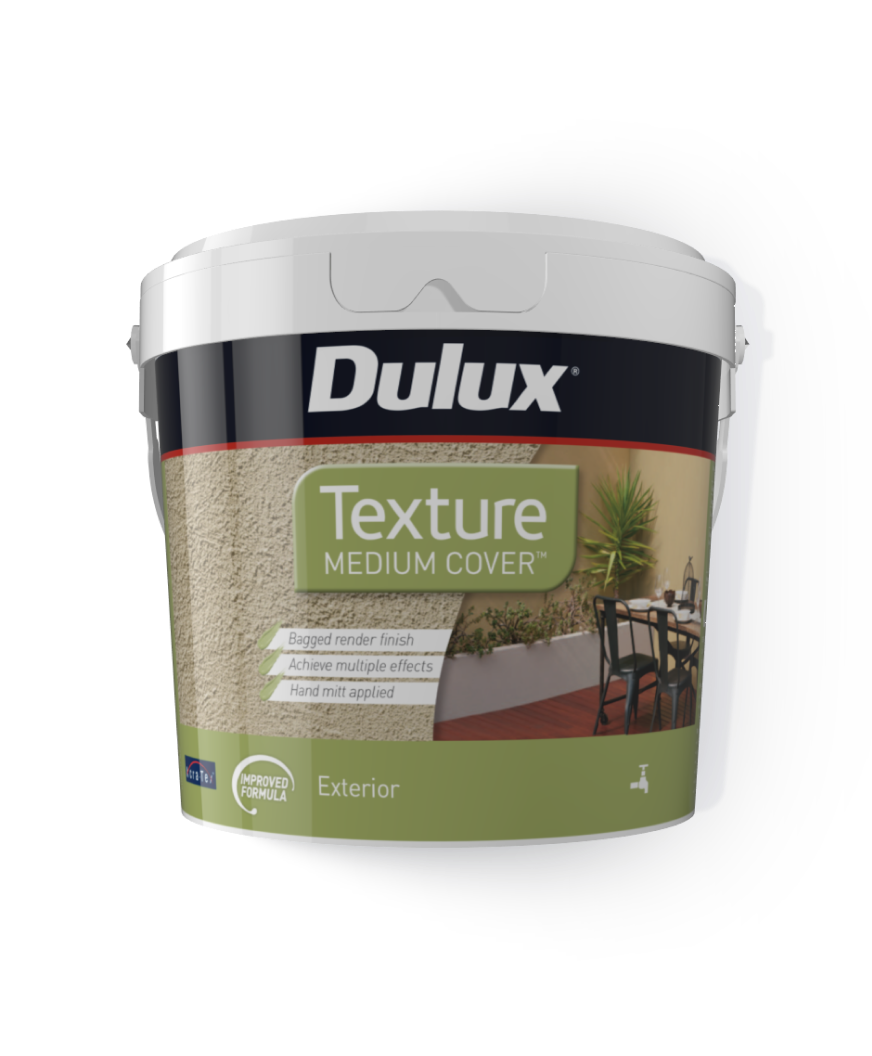Texture Medium Cover™

About Texture Medium Cover™
Dulux Texture Medium Cover™ is ideal for creating a coloured, mottled appearance over brickwork. It is perfect for diffusing, but not completely hiding the brick pattern. It can also be used to create a textured effect over smooth masonry surfaces. A range of effects can be easily achieved by finishing Texture Medium Cover™ with a lambswool hand mitt applicator, sponge, brush or broom.
Downloads
Application
At a glance
- Water-based
- Available in 4L, 10L
- Achieves texture finish without special training
Areas to use
Surfaces
• Bricks
• Cement render
• Masonry
• Fibre cement surfaces
Previously Painted Surfaces
• All surfaces must be thoroughly cleaned and free of all dirt, loose and flaking paint.
• Efflorescence or mould must be treated before application of paint.
• New concrete, mortar or cement render must be allowed to cure for four to eight weeks depending on concrete thickness and drying conditions.
• Block down unpainted brick and concrete surfaces using a brick or masonry rubbing stone to remove high spots and loose sand, then broom down.
• To test the adhesion of previously painted surfaces, cut an X through the existing paint with a sharp blade, press cellulose tape firmly across the cut and then rip the tape off.
• If the old paint or render comes off, it should be removed.
• On porous surfaces, applying a priming coat thinned with water (four parts Texture Medium Cover™: one part water) will condition the surface and help aid application of additional coats.
Brush, roller
Application is in two parts:
Delivery via a roller and finishing using a sponge, brush or mitt.
Delivery:
• Generously load the roller and apply from the ground upwards in vertical strips of half to one metre lengths.
• Reload the roller after each strip and repeat until three or four strips are applied.
• Even out material by rolling diagonally across the surface.
• It is important to work swiftly to allow time for the finishing process and this can be best acheived by working in a team, with one "delivering" and the other "finishing".
Finishing:
• Working with a clean bucket of water and a sponge (we recommend a fine cell sponge) or mitt, wet the sponge or mitt and, working in a circular motion, sponge finish the applied material to obliterate the roller pattern, fill mortar joints and/or cover surface imperfections.
• Clean out the sponge in the water and lightly finish in larger circular strokes.
• Depending upon the finishing pressure and material retained from the sponge, varied finishing effects can be achieved, from a light "mottled" effect to a more prominent "swirl" pattern.
• Repeat the above delivery and finishing procedure, maintaining a working wet edge, until completed.
• Two coats are recommended, but additional coats may be required depending upon the depth of the mortar joints.
Unused paint
Do not pour leftover paint down the drain.
Unwanted paint should be brushed out on newspaper and allowed to dry, and then disposed of via domestic waste collections.
For more information on responsible disposal of paint and packaging visit painttakeback.co.nz or paintback.com.au.
For more information visit paintback.com.au
Empty paint containers
Leave empty paint containers open in a well-ventilated area to dry out. When dry, recycle the container via steel can recycling programs.
Disposal of empty paint containers via domestic recycling programs may differ between local authorities. Check with your local council first.
Do not reuse container unless thoroughly decontaminated.
For more information on responsible disposal of paint and packaging visit paintback.com.au or painttakeback.co.nz
For more information visit paintback.com.au
Get in touch with our local Help & Advice team by calling 13 25 25. The Dulux Help & Advice team are experts available to assist with colour, product and service questions.
